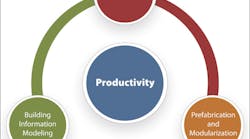The race to the bottom of the construction market during the economic downturn has been fierce and bloody. The current perception of the marketplace revolves around being the low-priced provider with little room for value propositions. Electrical contractors routinely lament that their general contractor customers care only about the bid, with the continual downward pressure on price further fueling this belief. There are plenty of contractors that are manipulating the market and “buying work.”
As long as there is one bidder willing to work for cost — or even less in some cases — the paradigm of low-cost providers wins. A less popular phenomenon, but one that bears contemplation, is that some of these “buying” contractors are, in fact, more efficient and productive than their peers. “There is no way the competition can do it for that,” is a fairly bold proclamation heard throughout contractor bidding war rooms daily. But what if even 50% of the competition is able to not only to do the job for that price, but also make money in the process?
Many contractors fail to envision how the competition could possibly vary its construction practices enough to have such a dramatic effect on price. Considering the fact that contractors have such variation in the ways they individually track direct and indirect costs, it’s not so hard to see how so much variability could exist. It is also common for an estimator to envision a project from one perspective while a superintendent interprets it completely differently. Estimated and actual costs are rarely equal in the same company; therefore, costs across firms are less likely to be equivalent. Simply put, electrical firms that fail to recognize the differences in construction — however small or large they may be — live in a myopic and limiting vacuum.
Efficiency is quickly becoming the mantra across construction organizations. Whether you examine its foundation in Total Quality Management (TQM) or its younger relative, Lean Six Sigma, firms recognize the reduction of waste as an essential strategic imperative. Maintaining pace with the competition is no longer good enough. Production assets leveraging technology with seamless integration and a consistent, standardized approach provide not only short-term gains, but also a demonstrable platform for long-term sustainability. Lean construction, prefabrication/modularization, and building information modeling (BIM) represent the current concepts available to electrical contractors as well as a glimpse into the future of construction (Fig. 1). Although construction technologies vary, there is no question that the construction contractor of tomorrow will resemble a manufacturing firm rather than a traditional electrical contracting firm. Controlling the assemblies, mitigating the many risks, and reducing inefficiencies all converge in the “perfect storm” of productivity improvement.
One misconception is the belief that adoption of one or all of the aforementioned systems will immediately provide a return. There are no “silver bullets” or panaceas in any business — and the construction industry is no exception. For instance, once people discover the benefits of lean construction, they might soon become enamored with grandiose expectations of waste reduction. The value is clearly there, but the largest hurdles to overcome lie in changing behaviors and a general reluctance to adopt a new paradigm by a firm’s associates. Incorporation of a lean culture is not unlike dieting and getting healthy — on the surface, it is the right thing to do, but battling the behavioral inertia associated with a sedentary lifestyle becomes the greatest barrier to change. All productivity drivers carry benefits, but it is important to recognize the pitfalls associated with each one.
Slimming down
Lean construction’s foundation stems from the automotive manufacturing sector. Known as the “Toyota Production System,” experts carefully analyzed every aspect of the production cycle — from how materials were stocked to how the fabricators interacted with the finished product. By its strictest definition, “lean” is the continuous elimination of waste driven by customer satisfaction. Combined with six sigma — another methodology for improving effectiveness and efficiency — lean aims to drive out waste of all forms, including, but not limited to, the following:
- Defects — construction not completed to specifications the first time.
- Overproduction — construction that is faster, sooner, or more than required.
- Waiting — time lost when people, materials, or equipment are kept waiting.
- Nonutilized talent — wasted potential when the people doing the work are not consulted for improvements to the methodology.
- Transportation — poor handling of materials and equipment around a site.
- Inventory — excess materials not needed.
- Motion — movement of personnel and equipment that does not add value.
- Extra processing — doing more than the specified requirements to transform the raw materials into the finished product.
Experts have long viewed the construction industry as simply an extension of the manufacturing process, making lean methodologies applicable to any trade. Excitement and intrigue about lean practices have contractors at a fever pitch. However, the overall concept of process improvement is far from new. FMI’s “2012 Productivity Survey” recently examined lean construction and its implications on the industry. Figure 2 illustrates that an overwhelming 42% of survey respondents felt that lean is more or less management best practices rehomogenized under a new heading.
As you examine the connectivity between such management philosophies as lean, TQM, and six sigma, it is easy to see many of the same figures leaving their indelible mark. Regardless of the packaging, it is important to recognize that the processes and tools for driving out waste, poor quality, and inefficiency provide results. Six sigma’s DMAIC (define, measure, analyze, improve, and control) methodology, which helps consultants and organizations alike develop solutions, is a timeless foundation for any best practice development. Elimination of “labor waste” greatly affects contractors and their customers.
While perceptions of lean construction may vary, translation to bottom-line growth is apparent. Figure 3 shows that 77% of survey respondents saw some level of productivity enhancement as a result of their lean initiatives.
For electrical contractors that achieve a net income as low as 2% to 3%, a 5% to 10% improvement in labor productivity has the ability to double the bottom line. While businesses appear far too concerned about top-line growth, productivity
improvements impact the more important aspect of the income statement.
As discussed previously, the challenges of lean lie not with the tools themselves, but in the deeply ingrained behaviors associated with the status quo. For instance, short interval planning tools, or “last planners” in lean terminology, are important proactive devices to help field managers allocate resources and set measurable goals. The benefit is clear — better planning eliminates emergencies and reduces costs associated with overtime, quick shipping, rework, etc. However, adoption of a new planning system across a contingent of managers and supervisors is not easy. Without strict accountability metrics from senior management, the planning tools simply become another sheet of paper.
Skepticism of new doctrines like the lean concept does not originate from disbelief in the tools or process but rather in the inability of an organization to change simple human behavior. Superintendents and managers need to see how new tools and processes will reduce costs over the long term, while changing their habits in the short term. Just as one needs to change a car’s oil on a long journey, businesses need to incorporate new systems on theirs. It is incumbent on construction firms in this new era to create sustainable models that allow their personnel to construct projects as efficiently as possible. Whether you call that lean, six sigma, or TQM is irrelevant.
Building Information Modeling
Building information modeling. Dramatic changes in the design of projects have had one of the most influential changes on contractor productivity. Interestingly enough, the groundswell in this design enhancement has been led by trade contractors — particularly mechanical and electrical contractors — not by the designers. Recognizing the need to compensate for poor or inadequately designed structures and systems, contractors assumed the reigns of this 3D or 4D design tool to control their risk and delivery higher quality finished projects. According to FMI’s survey, 63% of respondents have engaged in a project on which BIM was used (Fig. 4).
From a strategic perspective, firms must make a serious commitment to the long-term use of BIM. Many firms view the costs associated with rework, inefficiency, and poor coordination as enough motivation to consider integration of such a system. The contrarian view is the considerable investment and operational costs associated with BIM, which have a tendency to scare many contractors away from adoption. Figure 5 shows that 62% of the respondents experienced some increase in their labor productivity relating to the application of BIM.
One could argue that while labor savings occurred on these projects, there was the corresponding cost associated with BIM that offset any savings. Furthermore, the cost only exists because of inefficiencies in the delivery system and compensation for design inadequacies. Regardless of the rationale behind needing BIM, it is important to recognize that the likelihood of designs improving in the short and long term is doubtful. Architects and engineers are under many of the same budgetary constraints as contractors, and within this risk-adverse business, contractors are better-suited to adopt and cope rather than argue and complain. Proactive contractors recognize the movement toward this model is inevitable. In fact, the future is less likely to include a world without BIM, but, more likely, BIM 2.0. The software capabilities are no longer limited to simple 3D designs, but also incorporation of budget and scheduling dimensions to further aid in the ultimate goal — better construction.
Electrical contractors view this as a platform to supplement their prefabrication capabilities. One of the main challenges to BIM is in the overall adoption across a team of contractors, not just by the individual firm. It is much like the early days of the fax machine — a great tool, but the real benefits are realized when everyone has one. According to the summary in Fig. 6, respondents to the productivity survey declared that “clash detection and interference management” remain the primary tactical reason for BIM.
Costs associated with an unproductive crew waiting on a resolution to a conflict are enormous. There are countless case studies demonstrating the power of clash detection by eliminating requests for information and contentious claims. It is apparent that BIM offers not only direct correlation to labor productivity, but also customer management, trade coordination, and material handling. BIM’s larger role in the world of integrated project delivery provides another competitive advantage for organizations seeking to avoid the fray of the hard bid marketplace. However, just like any strategic initiative, it is imperative for contractors to recognize that there is little room for dabblers — BIM requires a wholesale investment.
Technological enhancements relating to productivity are not limited to BIM. Truly innovative electrical contractors are using everything from RFID tags for tools and materials management to handheld devices, such as tablet computers, to drive information to the field. Drawings, specifications, planning documents, time reporting, and labor-cost feedback are just a few examples of data being shared in real time with field managers and foremen. No longer is it necessary to wait 30 days to evaluate job performance. Instantaneous flow of information allows everyone to know the score of the game. More importantly, many of these tools are extremely cost-effective and require a significantly smaller investment than one would anticipate. The infrastructure required is minimal and, more importantly, the training required to drive the necessary change is less than the anticipated commitment of learning the intricacies of a laptop. The main theme electrical contractors should recognize is the embracing of new technology and the incorporation of productivity enhancers. With some of these alternatives, there is the question of investment a firm needs to consider. However, there are equally lower-cost options available that may integrate with minimal conflict. Neophyte thinking is dangerous, and too often contracting organizations assume the role of laggard. It is acceptable to be innovative and be in construction simultaneously.
Prefabrication and modularization
Whether inspired by the engineering spirit of the “Extreme Home Makeover” or simply recognizing the similarities to the manufacturing world, prefabrication and modularization have begun to revolutionize the construction industry. Many contractors are examining their projects from the perspective of what they can prefabricate rather than what they cannot. Electrical contractors are one of the main benefactors of prefabrication, and more of them are using a controlled environment to mitigate site risks and lower their labor expenditures.
Both concepts (lean construction and BIM) bear significant weight in the world of prefabrication. BIM creates spools of documents that allow for fabrication that is more accurate, while lean construction principles correlate even more to this new manufacturing setting. Many experts agree that construction in future generations will more accurately resemble an assembly line, with workers piecing systems together in the same way a factory worker connects an engine to a chassis. Unions will debate the intricacies and nuances of “ownership,” but smart businesses are recognizing the need to build more efficiently through the dictation of the end-users and customers. Labor issues aside, few can argue the benefits of constructing an electrical system in a climate-controlled facility, as opposed to the extreme elements of a northern winter or southern summer. Additionally, prefabrication provides mitigation against safety hazards that exist in one of the world’s most dangerous workplaces. According to Fig. 7, 69% of the respondents have engaged in some sort of prefabrication on their projects.
Prefabrication also allows for improved scrutiny of production rates by limiting external factors that impact construction. With the exception of extremely customized construction and construction within the bounds of unknown site conditions, there are few examples where even small prefabricated or modularized products would not benefit an electrical contractor. Furthermore, the list of prefabricated and modularized systems continues to grow:
- Bathroom pods (in conjunction with mechanical and plumbing peers)
- Hospital headwalls
- Pipe racks and assemblies
- Raceways
- Conduit banks and junction boxes with applicable feeders
Much like BIM, case studies abound about contractors building complex and sophisticated projects using this delivery system, all while saving time and money. However, unlike BIM, the initial investment in prefabrication is much lower. Careful experimentation is allowing new contractors exposure with less risk and less investment. The greatest hurdle that these businesses will encounter lies in the human element. Spatial constraints aside, individual can-do attitude is a pitfall that must be monitored and adjusted. Should further evidence be required, Fig. 8 illustrates the savings achieved through prefabrication.
Overall, 98% of the survey participants achieved at least a 1% labor savings. A proponent of prefabrication and modularization would argue that as the process becomes further ingrained, firms would naturally achieve higher savings through consistency, standardization, and repetition. Once again, in this controlled environment, measurement is achieved through process transparency, ultimately allowing enhancements to the production techniques.
Many electrical contractors give the concept of productivity lip service — they know they need to do it but they fall victim to the circumstances surrounding them. Poor designs, onerous contracts, inconsistent site conditions, and demanding owners appear to command more attention than focusing on controllable factors associated with their businesses.
Market conditions have necessitated the need to make productivity a strategic priority. Simply building a better mousetrap will not suffice. Electrical contractors must take an exhaustive and introspective look at how they build. Change at the field level truly begins at the top of the organization. Once the leaders of the organization are committed to making any enhancement for the good, then they can begin not only to employ new techniques and tactics, but also to address the human element.
Lean, BIM, and prefabrication are mere examples of productivity enhancements in 2012 and the coming years. One inalienable truth that exists is the need to commit to efficiency, regardless of the buzzword.
Schoppman is a principal with FMI Corp., headquartered in Raleigh, N.C. He can be reached at [email protected].



